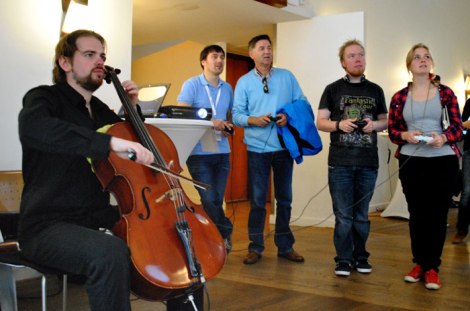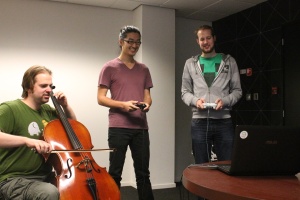Play Of Life interviewed Dutch game developer Joost van Dongen about his latest game, Cello Fortress, and his general philosophy about games. Cello Fortress is a “unique combination of a game and a live music performance. A cellist defends a fortress by improvising on his cello. Melodies control the guns, dissonant notes activate the flamethrowers. Players from the audience use game controllers to steer their tanks and attack the fortress.”
About Cello Fortress
1. This is really a unique game. What inspired you to combine live music with a digital game?
Cello Fortress is a really weird combination, but to me it makes perfect sense: I have been playing cello for over 20 years and have been experimenting with electronics and improvisation quite a bit. I am also a professional game developer, so combining the two seems logical to me. It took me years to come up with a way to actually do it, though: before I came up with Cello Fortress, I had all kinds of ideas that were totally different or just didn’t work.
2. Could the game expand to include other instruments?
The core concept is just instrument versus audience, or even just instrument-controls-game, so in that sense: yes, that could be done with any instrument. Cello Fortress is specifically designed for the cello, though, so only instruments that are sufficiently similar could control the game as it is now without major modifications. I could, for example, very easily modify the game to work with a violin.
3. Why cello vs. game controller, as opposed to cello vs. cello or some other musical instrument?
I wanted the game to not just be about the cello, but also about a confrontation between the audience and the game developer/musician. For that you need cello versus game controller. At the same time, I can imagine cello versus cello could make for an awesome stage performance, where the audience does not interact and simply enjoys the show. The reason it is specifically a cello, is of course that I am a cellist myself. I like to make games that are close to me personally. Just like Proun is inspired by abstract art from the first half of the 20th century for the simple reason that that is my favourite art period.
4. Playing Cello Fortress is a performance as much as it is a entertainment. What do you think of digital games as being a spectator sport (such as Starcraft)?
I think eSports like Starcraft are a completely different thing from Cello Fortress. In such games there is nothing to see in the player himself, it all happens on the screen. In Cello Fortress however the cellist really gives a performance. Without the game, there would still be a live solo cellist, which is still great. Both eSports and performances like Cello Fortress can be really awesome for the audience, but of course eSports are already happening on a big scale, while Cello Fortress is something new that opens up a whole world of possibilities. I hope others will get inspired by it and explore this new genre further.
5. What kind of reactions, if any, have you got from traditional musicians?
Very positive, so far! Quite a few cellists have contacted me about wanting to play it. Some older cellists seem to think it is only for kids, but most people who hear of it, seem to be curious about trying it.
About You
1. You are a game designer, coder, animator, musician, and artist. (Did I miss anything?) How do you describe yourself to others when they ask what you do?
Game developer. I make games. Or lead programmer, since that is my role at Ronimo and thus the most important thing.
2. Can you tell me a little more about what you do at Ronimo?
I am one of the seven founders of Ronimo, and I am lead programmer. Originally I was the only programmer, but after the launch of Swords & Soldiers on WiiWare we have hired more programmers, so now I lead a team of 6 coders. As a co-founder I am also involved in a lot of our business things.
3. Do you ever see yourself working for a very big AAA game company?
Currently not. I dislike being a small cog in a big machine, and I also personally enjoy most indie games better that AAA games, so I’d rather make those small gems. Maybe somewhere far in the future if I could be a lead at an AAA developer I would consider it, but right now I’d rather make indie games, just like we do at Ronimo.
4. What is your philosophy, if any, on the purpose of playing games?
The main purpose is fun. Players need to have a good time. A big bonus is if the game also gives a meaningful experience, by broadens the player’s mind in some way, or by surprising, or giving insights or invoking special feelings. Dear Esther and Braid are good examples of games that had that effect for me. I hope Cello Fortress broadens people’s idea of what games can be.
5. When considering 2D vs. 3D for a game, what are the benefits for choosing high-polygon?
3D gives freedom to the camera, which opens up an enormous amount of gameplay and graphics possibilities. On the other hand, 2D has much more personality and a broader set of possible styles. For us at Ronimo: our artists are really good at 2D, and I think our games are amongst the AAA of 2D. If we would switch to 3D, we would be competing with games like Uncharted, which is just out of any small team’s league.
6. What was the most memorable game you’ve ever played?
Star Control II. The personalities of the aliens, the music, the humour, the big universe that the player is free to explore. Still easily my favourite game of all time, despite that it is over 20 years old now. I think the freedom in the exploration, in combination with the rich story and world, is something that has never been done as well as in Star Control II.
7. Does your Dutch identity play a role in how you think about game design? If so, how?
I am personally not really aware of the Dutchness in my design, but I went to the Utrecht School Of The Arts, and that greatly shaped my way of thinking. I guess their creative philosophy is pretty Dutch, since they link quite well into the famous Dutch Design. So in that sense I guess I can be called typically Dutch, but I don’t know exactly what that would mean. I also really like Dutch cheese.
8. You’ve developed games such as Proun, that have been exhibited in museums. Are all games art? If not, what makes a game a work of art?
The medium of games is just that: a medium through which one can express oneself. Just like paintings, sculpture, literature, music or film. So yes, games can definitely be art. I don’t think all games are art, though: art to me implies a certain depth and quality. Not all games are are, just like not anything anyone does with a brush on canvas is automatically art. Defining the difference is impossible, though.
9. What game do you think you’ll be designing (or want to design) 10 years from now?
I have tons of ideas floating around, and at Ronimo my colleagues have even more, so I don’t know which ones will happen, or when. One specific concept I would really like to make at some point is a top-down open world exploration game like Star Control II. I have some ideas that can take the concept of exploration much further than other games do. In fact, I have a rather complete game design lying around for that, but making that would take years, so I don’t know whether it will ever happen.

